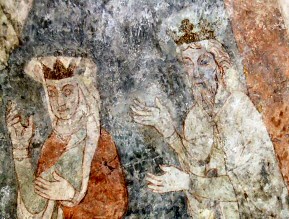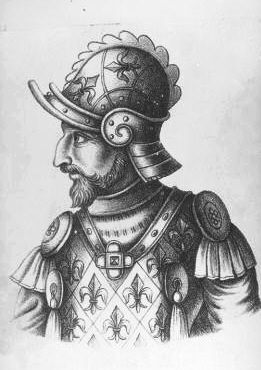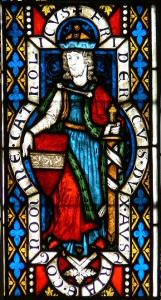Burial place of the Babenbergs in the chapter house
The Babenbergs lie in the floor of the chapter house of Heiligenkreuz Abbey. Unfortunately, visitors are constantly trampling on them. They do not know what they are walking on when they come to the chapter house in the course of a guided tour. As a result, the inscriptions on the grave slabs are no longer legible, or in some cases have completely disappeared. Thank God Empress Maria Theresa had an accurate drawing made of the tombs. This diagram helps us in our search for Gertrud.
Click on the gravestones to find out who lies underneath!
even more clickable gravestones
Under which grave slab is Gertrud? Just click on the marked graves.
For smartphones: click on the grave numbers!

Graphic representation of the chapter house from the 18th century with the tomb of the Babenbergs.
Allow me to make a side note: there is something wrong with Tomb XI!

In search of Gertrud:
In addition to the high grave of Frederick the Quarrelsome, there are 10 grave slabs here. On which slab do we want to place the digital rose for Gertrud?
Click on a grave slab on the graphic above.
Adalbert and Ernst, sons of Leopold III.

Adalbert is the eldest son of Leopold III. He probably comes from a first marriage (to one of Perg). He exercises the bailiwick rights over numerous monasteries. After his father's death, he fought with the other sons over the inheritance. Leopold IV came first. Agnes, Leopold III's wife, may have had a hand in this. Adalbert died in 1138, two years after Leopold III.
Ernst the Youngling (d. 1137), a son of Margrave Leopold III, is seen here at a hunting scene. Very little is known about him. His birth is put around 1110, later he is mentioned several times in documents as a witness. He was first buried in Klosterneuburg Abbey and later transferred to Heiligenkreuz. It is reported that he was a famous hunter, hence the depiction of a stag hunt.
Heinrich der Ältere (Henry the Elder) of Mödling and his wife Richza

Duke Heinry the Elder of Mödling (1158-1223), a son of Duke Heinrich II Jasomirgott and Theodora Komnena of Byzantium, had received the dominion of Mödling from his brother Leopold V, where he also had his seat. His epithet is somewhat confusing, Mödling was of course not a duchy in its own right, but it experienced a great upswing under Henry. The depiction shows Henry's march to Moravia, where he was victorious against the Bohemian Duke Sobieslaw, who had previously invaded Austria.
The castle in the background is Mödling Castle, where Walther von der Vogelweide was also a guest of Duke Heinrich. The view seems to be truthful, but this cannot be determined exactly, as nothing of the castle remains today.

Heinry the Elder is still commemorated in Mödling today by the Karner, as the Pantaleon Chapel has been called in documents since 1346. It was probably built shortly after 1182.
The small loggia and the capitals on the half-columns date from this time. A fresco in the apse of the charnel depicts Richza and Heinrich (image digitally processed).
Heinrich Jasomirgott was also active as a builder in Mödling, as shown by an inscription on the former poor pilgram's house, which is now used as a parish home.
Duke Leopold IV

Leopold IV, * 1108 (?), † 18. 10. 1141 Niederaltaich (Germany), son of Leopold III, Margrave of Austria (as of 1136).
Duke of Bavaria (from 1139)
Although younger than his brothers Adalbert and Henry II (Jasomirgott), Leopold IV became Margrave of Austria in 1136.
In 1137, the Treaty of Mautern was concluded with the Bishop of Passau. The treaty included the exchange of goods, which was to enable the bishop to build a place of worship outside of what was then Vienna, which was to be dedicated to St. Stephen, the patron saint of the diocese of Passau. At that time there were already two churches in Vienna, the Ruprechtskirche and the Peterskirche. The first Romanesque building of St. Stephen's was completed around 1147 and was far too large for the population of the time. The church was aligned with the sunrise of St. Stephen's Day, 26 December 1137.
Under his rule, the Kuenringers founded the monastery of Zwettl, which he confirmed and endowed.
Due to the conflict between King Konrad III and Henry the Proud (first husband of Gertrud), Henry was deprived of his power and Leopold IV became Duke of Bavaria in 1139. He was only able to assert himself there with great difficulty and the massive support of his stepbrother King Konrad III.
This struggle for supremacy in Bavaria occupied him until the end of his life.
Heinrich der Jüngere (Henry the Younger) of Mödling

Duke Henry the Younger of Mödling (1223-1236?) was the son of Duke Henry the Elder. With him the Mödling line of the Babenbergs became extinct. After his death, his possessions fell to Duke Frederick II. Henry did not excel politically, but his court life attracted economic and cultural forces. He became known as an excellent hunter. It is in this capacity that he is depicted here on the Babenberg family tree (Klosterneuburg Abbey).
The scene shows a bird hunt. While in the foreground a hunter aims at waterfowl with a crossbow, the duke rides up with a hunting falcon. The moated castle on the right is a faithful reproduction of Laxenburg Castle, which, however, did not yet have this shape at the time of Duke Heinrich. The Gothic form of the castle dates from the 14th century.
Duke Leopold V.

Leopold V (* 1157; † 31 December 1194 in Graz) was Duke of Austria 1177-1194 and of Styria 1192-1194.
Already during the lifetime of his father Heinrich Jasomirgott, Leopold V was enfeoffed in 1174 with Austria, which had in the meantime been elevated to a duchy (1156). After
his death in 1177, he also succeeded to the duchy. Through treaties with Duke Otakar IV, Leopold secured for himself and his son Frederick the succession to the Duchy of Styria,
today's Styria.
From a pilgrimage to the Holy Land, Leopold brought a large relic of the cross back to his homeland and gave it as a gift to the monks of Heiligenkreuz. To this day, this precious
relic is kept and venerated in the monastery.
Leopold V also joined the Third Crusade. During the siege and conquest of Acre on 12 July 1191, he came into conflict with the English king Richard the Lionheart. The latter is said to have torn down an Austrian standard, whereupon Leopold V returned to his homeland in a huff.
After the end of the crusade in 1192, Richard also set off with his fleet, but was shipwrecked at Aquilea and had to take the overland route to get to England. Although disguised as a pilgrim, he was recognised in Vienna (Erdberg) at the end of December 1192, apprehended and imprisoned by Leopold V at Dürnstein Castle. The following year, Leopold delivered his prisoner to Emperor Henry VI and received part of the extorted ransom in return.
 Leopold V, stained glass window in the well house in the cloister of Heiligenkreuz
Abbey.
Leopold V, stained glass window in the well house in the cloister of Heiligenkreuz
Abbey.
Duke Frederick I

Frederick I (* around 1175; † 16 April 1198 on his way home from Palestine) was Duke of Austria 1194-1198.
Contrary to earlier plans, the reign was divided after the death of Leopold V.: His eldest son Frederick I received the Duchy of Austria, while his younger brother Leopold VI ruled over Styria.
The first years of Frederick's reign in Austria were burdened by the mortgage of his father's politics. After tough negotiations, he had to agree to repay the unspent part of
the ransom his father had received for the capture and extradition of King Richard the Lionheart. Furthermore, Frederick vowed to take part in an upcoming crusade, which he also
embarked on in 1197.
Already in the following spring of 1198, far from home, he was struck down by a serious illness. His body was transferred more teutonico - i.e. only the (boiled) bones - to
Austria. Like his father, he was buried in Heiligenkreuz.
The thought that his body was boiled is horrible for us today. But for the time, this method was extremely practical: less weight and no stench.
Heinrich der Grausame (Henry the Cruel), son of Leopold VI.
 The second son of Duke Leopold VI was married in 1225 to Agnes, the daughter of
Landgrave Hermann of Thuringia. In 1226, during his father's absence, he conquered Hainburg and expelled his mother Theodora.
The second son of Duke Leopold VI was married in 1225 to Agnes, the daughter of
Landgrave Hermann of Thuringia. In 1226, during his father's absence, he conquered Hainburg and expelled his mother Theodora.
He died in 1227.
The picture from the Babenberg family tree shows the conquest of Hainburg on the right and Theodora's flight on the left.
Agnes von Thüringen (Agnes of Thuringia), wife of Henry the Cruel
Agnes of Thuringia, born around 1206, died in 1247, daughter of Hermann I of Thuringia and Sophie of Bavaria.
Ecclesiastical marriage (1) on 20.11.1225 in Nuremberg to Henry of Austria (the godless, the cruel).
Church marriage (2) after 1228 with Albrecht I of Saxe-Wittenberg. After the death of Henry the Cruel, his widow Agnes marries a second time in Wittenberg on the Elbe.
From the first marriage comes 1 child, the daughter Gertrud.
From the second marriage come:2 children.
 Supposedly she is also buried in Wittenberg. That would only be logical; her
second husband Albrecht I would hardly have taken her back to her first husband.
Supposedly she is also buried in Wittenberg. That would only be logical; her
second husband Albrecht I would hardly have taken her back to her first husband.
Who do you think is lying there in Heiligenkreuz? This is what it looks like under the gravestone.
For those who are interested, I have prepared a family tree of Agnes of Thuringia.
![]()
Rudolf and Henry, grandsons of Rudolf of Habsburg
The first Habsburgs tried to take over the traditions of the Babenbergs in order to legitimise their succession. This is probably why the two Habsburgs are buried here.